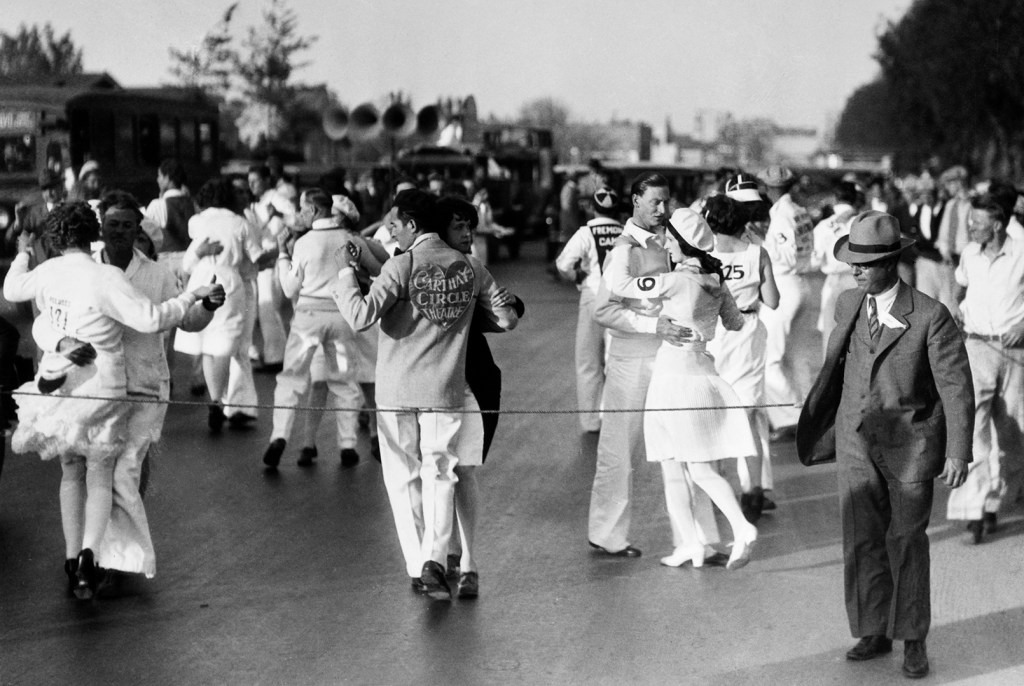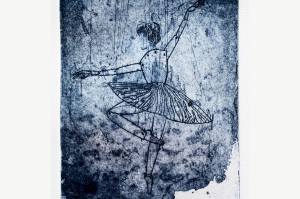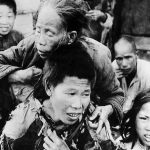On March 31, 1923, Alma Cummings put her feet into a bowl of cold water. Then, tired-eyed but smiling obligingly for the photographer, she held up her dancing shoes. There were holes in both soles. Cummings had just finished a 27-hour stint of waltzing at a Manhattan ballroom, wearing out not just her shoes, but six male partners in the process. The dance instructor was one of the Americans responsible for a strange cultural phenomenon that swept the United States over the next two decades — dance marathons.
Cummings’s record was soon beaten and within a few years promoters were organizing public competitions across the States in which couples danced for hours, days, months even, to win prize money. Some collapsed and even died in the process. In 1928, Gladys Lenz danced 19 hours straight at a Seattle marathon even after getting punched in the jaw by a partner who, newspapers reported, ‘went squirrelly’. Fatigue-induced psychosis was not uncommon among contestants. After receiving $50 for coming fifth, while the winning couple waltzed off with $1,000, Lenz attempted suicide.
In 1933, Callum DeVillier and Vonny Kuchinski of Minneapolis took first prize in a marathon at Somerville, Massachusetts, after dancing for five months. A headstone in the Showmen’s Rest section of Minneapolis’s Lakewood Cemetery reads: ‘DeVillier, World Champion Marathon Dancer 3,780 continuous hours.’ He and Kuchinski, subjects of the 2018 stage musical Dance ’Til You Drop, show up Dancing with the Stars for the mimsy charade that it is.
But while endurance hoofing has long been seen as symptomatic of American desperation during the Great Depression of the 1930s, with poor folk battling for prizes sometimes worth more than a farmer’s annual income, dance marathons arose in the more optimistic and prosperous Roaring Twenties. They originated at a time like ours, when humans were tentatively trying out a new move. Let’s call it the Post-Pandemic Shuffle: two steps forward, one step back, moving uncertainly from quarantine to public life in the shadow of a virus. The Spanish flu of 1918-20 killed 50 million people, more than the number of combatants and civilians who had died in the first World War. It infected 500 million, about a third of the world’s population.
Filling a dance card with strangers’ names may be unthinkable for the moment, as we sit in semi-lockdown, but we have much to learn from the spirit that gripped America a century ago. Carnivals and fairs spread after the World War One, writes the critic Hanif Abdurraqib in his new book, A Little Devil in America, making feats such as flagpole-sitting and weightlifting popular entertainments. As Abdurraqib puts it, in the 1920s ‘Americans became more obsessed with the impossible’ — as if they were proto-Buzz Lightyears reaching for infinity and beyond.
This trend for testing bodily limits was spurred by the modern revival of the Olympics in 1896, but also by the rise of measurable industrial performance. Only a decade before Alma Cummings wore out her shoes, Henry Ford opened the world’s first mass-production moving assembly line in Detroit, reducing the time it took to make a car from 12 hours to two. His employees worked faster, harder and more efficiently than their peers and thereby helped Ford win market share.
Dance marathons replicated the structure of factory work in leisure hours. Every few hours a klaxon would sound and couples were allowed 15 minutes of rest in beds that were sometimes set up on the dance floor. During breaks, contestants would often pass out exhausted, only to be woken by the klaxon summoning them back to their dancing labors. Women who did not get up were given smelling salts and sometimes slapped.
Dancing was minimally defined as lifting one foot and then another in time to music, a loose enough definition to allow males to shave as they danced, using a mirror hung around their female partner’s neck. The division of labor was such that one dancer might read the paper, knit or write a letter using a folding desk held around the neck. As in Ford’s factories, there was shift work: a ‘carrier’ would hold up a dozing partner (more often than not it was the female who supported a sleeping male’s dead weight). Sometimes the ‘carrier’ would tie the wrists of the dozing ‘lugger’ with handkerchiefs and hook his arms over her neck.
Cummings’s triumph in 1923 was, Abdurraqib writes, ‘at the intersection of the era’s many fascinations: with excess, with endurance, with testing the limits of the country’s tolerance for more liberal sexual expression’. All those sweaty, clinging couples were doing vertically and in public what outraged moralists thought they should have done horizontally and in private.
In addition to voyeurism was the lure of money. ‘In their heyday, dance marathons were among America’s most widely attended and controversial forms of live entertainment. The business employed an estimated 20,000 people as promoters, masters of ceremonies, floor judges, trainers, nurses and contestants,’ writes Carol Martin in Dance Marathons: Performing American Culture of the 1920s and 1930s. Contests were sometimes rigged, with professional dance partners from out of town becoming ringers and beating the local rubes.
Dance marathons were also theaters of cruelty. ‘For some audiences, seeing others who were worse off was a balm to their own precarious circumstances,’ argues Martin. June Havoc, a vaudeville star who turned dance marathon competitor aged 14, wrote: ‘Our degradation was entertainment; sadism was sexy; masochism was talent.’ Men who slept beyond the requisite time limit were sometimes chucked in tubs of ice to the amusement of onlookers. In extreme cases, couples were held together by dog chains, reminiscent of prisoner chain gangs.
For all that, Abdurraqib is beguiled by the spectacle of two dancers in temporary alliance against time, space and a hostile world. ‘When the thick fog of exhaustion set in on a room, it was desire that kept a dancer’s body upright. When the desire wore off, it would be another dancer, pulling their partner up by their arms.’ Choosing one’s partner was a serious business . ‘Two people — sometimes lovers but sometimes siblings and sometimes barely even friends — had to commit to each other and the pursuit of staying on their feet.’ This was easier during the evening when live bands played and spectators cheered. ‘But the real test was during the daytime, when a radio merely droned out some dry melody and the spectators were few.’
Abdurraqib’s book is subtitled ‘In Praise of Black Performance’, and he properly notes that most dance contestants were white. ‘After all, what is endurance to a people who have already endured?’ His idea is that black dancers who lindyhopped in segregated bars made up in intensity for what white marathons did in endurance. The ‘little devil’ of his book is Josephine Baker, impish icon of intense black dance culture.
But while it is true that the white dancers who took part in dance marathons had never endured slavery, lynchings or Jim Crow laws, they had often suffered poverty and were drawn to such contests by the prize money, free meals and even shelter. After the 1929 Wall Street Crash, dance marathons drew the poor and unemployed in unprecedented numbers, as captured in Sydney Pollack’s 1969 movie adaptation of the 1935 novel They Shoot Horses, Don’t They? In Pollack’s film, a cast of desperate Americans, headed by Jane Fonda and Michael Sarrazin, hobble around a circuit in what looks more like a death march than anything to do with dancing. Meanwhile, Gig Young’s oleaginous MC whips the crowd up into a patriotic frenzy: ‘One couple and one couple only will waltz out of here, over broken bodies and broken dreams, with the prize of 1,500 silver dollars. And believe me, each one of these kids deserves your cheers because each one of them is fighting down pain, exhaustion, weariness, struggling to keep going, battling to win. And isn’t that the American way?’
For a while, perhaps it was. But disgust at suffering as entertainment grew during the Great Depression. Seattle banned dance marathons after Lenz’s attempted suicide. By the late 1930s, many more local authorities followed suit and so business dwindled.
Dance marathons have since been revived, but with a twist. While the theater of cruelty lives on in reality TV, dance marathons today exist chiefly as fundraisers. This November, Indiana University will celebrate its 31st annual marathon, planning to add to the $40 million raised to date for pediatric care. It is time-limited to 36 hours, so latter-day Alma Cummingses have plenty of opportunity to wear out shoes and partners. ‘We dance because we can,’ goes one of Indiana’s slogans. ‘We stand for those who can’t.’ Dance marathons were not always so benign.
A Little Devil in America by Hanif Abdurraqib is published by Random House. This article was originally published in The Spectator’s July 2021 World edition.

















